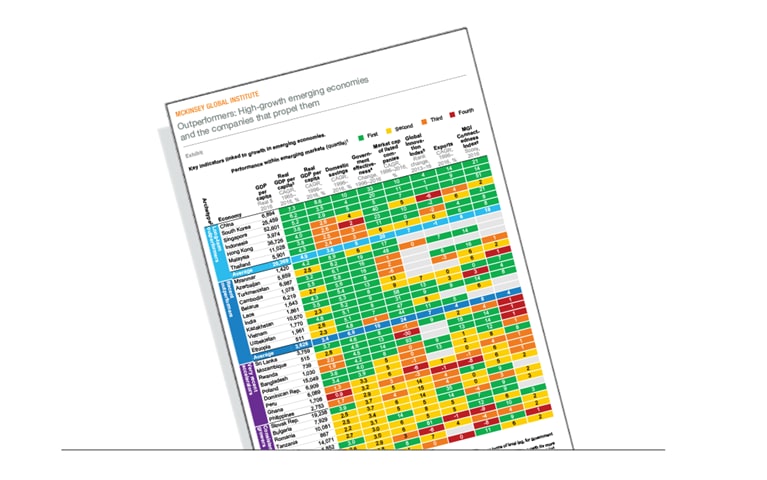Emerging economies have accounted for almost two-thirds of the world’s GDP growth and more than half of new consumption over the past 15 years. Yet economic performance among individual countries varies substantially.
In Outperformers: High-growth emerging economies and the companies that propel them (PDF–3.20MB), the McKinsey Global Institute looks at the long-term track record of 71 developing economies to identify the outperformers—and finds two key factors that help explain their outperformance: a pro-growth policy agenda of productivity, income, and demand that has driven exceptional economic growth, and the underappreciated but nonetheless standout role that large companies have played in driving that growth.
- Eighteen of 71 countries outperformed their peers and global benchmarks.
- A pro-growth agenda of productivity, income, and demand has driven outperformance.
- The role of productive companies is a key characteristic of outperforming economies.
- Changing times spell potential new opportunities for emerging economies.
- The global economy could receive an $11 trillion boost if all emerging economies emulate outperformers.

Eighteen of 71 countries outperformed their peers and global benchmarks
We analyzed the per capita GDP growth of 71 economies over 50 years, starting in 1965. Of these, we identified 18 as outperformers, about one in four.
Seven economies achieved or exceeded real annual per capita GDP growth of 3.5 percent for the entire 50-year period. This threshold is the average growth rate required by low-income and lower-middle-income economies to achieve upper-middle-income status over a 50-year period, as defined by the World Bank. The seven are China, Hong Kong, Indonesia, Malaysia, Singapore, South Korea, and Thailand.
We also found a second group of 11 more recent, less heralded, and more geographically diverse outperformers. They achieved real average annual per capita GDP growth over the 20 years between 1995 and 2016 of at least 5 percent. The 11 are Azerbaijan, Belarus, Cambodia, Ethiopia, India, Kazakhstan, Laos, Myanmar, Turkmenistan, Uzbekistan, and Vietnam.
These 18 countries not only showed exceptional average performance but also demonstrated consistency by exceeding the benchmark growth rate in at least three-fourths of the 50 and 20 years, respectively (Exhibit 1).

Collectively, these outperformers have been the engine for lifting one billion people out of extreme poverty, defined by the World Bank as living on less than $1.90 per day. Rising prosperity in these countries has not just reduced poverty but has also enabled the emergence of a new wave of middle and affluent classes. Between 1990 and 2013, the number of people living in extreme poverty in the 71 emerging economies fell from 1.84 billion to 766 million. Outperformers accounted for almost 95 percent of that change.
Less than 11 percent of the world’s population now lives in extreme poverty, down from 35 percent in 1990.
At the same time, growing numbers of residents of these countries joined the “consuming class”—that is, people with incomes high enough to become significant consumers of goods and services. In India, for example, the number of consuming-class households rose tenfold in two decades, from 3.4 million in 1995 to more than 35 million in 2016. Globally, these highly urbanized consumers have become a powerful motor for global economic growth. Outperformers accounted for almost half of the growth in household spending of all emerging economies in the past 20 years.

A pro-growth agenda of productivity, income, and demand has driven outperformance
While the 18 outperformers vary considerably—spanning different income levels, sizes, factor endowments, and regions—with the exception of Latin America, our analysis suggests they share foundations of similar pro-growth cycles of rising productivity, income, and demand (Exhibit 2). Part and parcel of these foundations are competition policies that created an impetus for productivity growth and helped forge the big companies that have driven a significant part of GDP growth.

More than two-thirds of the GDP growth in outperforming countries over the past 30 years is attributable to a rapid rise in productivity correlated with industrialization: an annual average productivity gain of 4.1 percent versus 0.8 percent for the other developing economies. That rapid development initially drives the pro-growth cycle by creating wealth and boosting demand, which translates into more jobs.
Capital accumulation—enabled by high rates of investment and domestic savings—contributed an average of 3.8 percentage points to economic growth each year between 1990 and 2015 for the seven 50-year outperformers in our sample, and five percentage points for the 11 shorter-term outperformers between 1995 and 2015.
Investment as a share of GDP averaged 30 percent for long-term outperformers and 20 percent for recent outperformers, or three to 13 percentage points higher than investment in other developing economies. The difference in domestic savings as a share of GDP was ten to 30 percentage points higher.
The outperformers could tap into higher levels of domestic savings, some of which was required by government-run pension-savings schemes, and some of which was encouraged by governments developing strong financial institutions and convenient digital banking services. Higher domestic savings enabled more investment in infrastructure, among other areas. Outperformers also attracted the largest share of foreign investment, almost 70 percent, of the approximately $900 billion invested in emerging markets between 2000 and 2016.
Strong productivity growth translated into exceptional income growth. Real wages and benefits rose by an average 4.6 percent annually in the seven long-term outperforming countries between 1980 and 2014.
China led the way, with incomes there rising by 8.6 percent annually. Among the more recent outperforming countries, real wages and benefits grew by 6.0 percent per year between 1995 and 2014. This was about triple the level in other developing and advanced economies. Household consumption spending generated by rising incomes grew about three percentage points faster in the 18 outperforming countries than in other developing or advanced economies.
Would you like to learn more about the McKinsey Global Institute?
Another essential feature of these countries has been their ability to achieve macroeconomic stability, even at a time of global volatility, by adapting policies to fit their local context and changing conditions. For example, governments took quick action to ensure rapid recovery from volatile episodes, such as the Asian financial crisis of the late 1990s and the global financial crisis of 2008 and 2009.
Outperforming economies have also benefited from their ability to tap into global demand growth through export markets, giving them greater economies of scale. In 1980, outperformers accounted for less than 10 percent of global inflows and outflows of goods, services, and finance. By 2015, they had increased their share to 20 percent or more.
Competition policies also created impetus for productivity growth. Many outperformer countries recognized the importance of competitive private-sector companies and nurtured environments in which they could invest and compete, even as they created incentives for productivity improvements. Rather than picking winning sectors or winning companies within sectors, they focused on boosting productivity within sectors.
As a result, sectors with a larger share of big companies grew faster, increased productivity by more than their peers, paid workers better, and realized greater levels of investment. In some, but not all, countries, governments helped incubate competitive domestic companies through sectorwide support for infant industries, including low-cost loans, preferential exchange rates, low tax rates, and R&D subsidies.
Protection, however, was gradually lifted as these industries became more competitive, limiting market distortions. In some cases, support was tied to conditions that encouraged companies to increase productivity. For example, South Korea’s import policy in the 1960s strictly limited all but strategic imports and imposed high tariffs, but the country gradually transitioned to a more (but still not entirely) open scheme in the 1980s.

The role of productive companies is a key characteristic of outperforming economies
While growth-and-development economists over the decades have extensively documented policies that have driven growth in emerging economies, the contribution to the growth of globally competitive, nimbly managed, and highly productive companies has been less studied. In the 18 outperforming countries, we find that these companies not only helped boost GDP but that they also are catalysts for change at home.
We define large companies here as public companies with annual revenues of at least $500 million. From 1995 to 2016, their revenue relative to GDP has almost tripled in outperformer developing economies—growing from the equivalent of 22 percent of GDP to 64 percent, close to levels in high-income economies and dwarfing levels in other developing economies. At the same time, we estimate that the contribution of value added by these outperformer companies to national GDP also grew rapidly, from 11 percent in 1995 to 27 percent in 2016—or double the share among non-outperforming emerging economies (Exhibit 3).

Large companies tend to focus on sectors that tap into global demand, which has helped drive a greater share of exports for the outperforming economies. They bring productivity benefits by investing in assets, R&D, and job training at a higher rate than small and midsize enterprises (SMEs)—and they tend to pay higher wages, upward of 75 percent more in countries such as Indonesia and South Korea. Along with these direct effects, large companies indirectly stimulate the creation, growth, and productivity of SMEs in their supply chains—and in turn depend on these SMEs to provide intermediate input for their ecosystem.
Rising to the top in the outperforming emerging economies—and then staying there—is by no means a foregone conclusion for large companies. Our analysis finds that the competitive dynamics in many (but not all) of the 18 outperforming countries can be brutal, with only the strongest surviving.
One indication of the competitive corporate environment is that outperforming countries have about twice as many big companies per trillion dollars of GDP as other emerging economies: just over 160 companies per $1 trillion in 2016 versus 80 companies in non-outperforming peers (and 95 in high-income countries). As a result, revenue growth is shared more widely.
Contested leadership is a vital sign of the competitive environment. Less than half (45 percent) of companies that reached the top quintile with respect to economic profit generation between 2001 and 2005 managed to stay in place for a decade, according to our analysis. That was far less than incumbents in high-income economies, 62 percent of which stayed in the top quintile for the same decade.
Domestic competition, in turn, has enabled the winners to earn a disproportionate share of revenue and income and to outperform their counterparts in advanced economies across key dimensions, including total returns to shareholders. For companies in high-income countries, the developing world has thus become both an opportunity for growth and the source of tough new global competition.
The rewards for the successful companies that stay on top are substantial: the top 10 percent of large companies with respect to value creation, in the outperforming emerging countries, captured 454 percent of the net economic profits generated by all companies. That is more than four times the proportion in high-income countries, where the top 10 percent captures only 106 percent of all net economic profit. But the penalties for failure are larger, too: the bottom 10 percent of companies in outperformer emerging economies accrues losses equivalent to 289 percent of the total, compared with 31 percent of the respective profit pool for top large companies in advanced economies.
The emerging-market companies that survive this rite of passage emerge as hardened and formidable competitors on the global stage. They cover a wide range of sectors, with significant differences depending on the structure of national economies.
Between 1995 and 2016, large, publicly listed companies in the outperforming countries grew their net income each year four to five percentage points faster than those in other emerging economies. On a global level, they contributed about 40 percent of the revenue and net income growth of all large public companies from 2005 to 2016, even though they accounted for only about 25 percent of total revenue and net income in 2016. More than 120 of these companies have joined the Fortune Global 500 list since 2000.
The best-performing companies also outdid companies in advanced economies on a key performance indicator: total returns to shareholders. Between 2014 and 2016, total returns to shareholders from the top quartile of outperformer companies was 23 percent on average, compared with 15 percent for top-quartile companies in high-income countries and 13 percent in non-outperformer emerging economies.
To understand the contribution of these big companies more fully, we surveyed executives from more than 2,000 companies across seven countries and ten industries. Three characteristics stand out:
Top companies in emerging economies devote more attention to innovation, deriving 56 percent of their revenue from new products and services, eight percentage points more than their peers in advanced economies. They invest almost twice as much as comparable businesses in advanced economies, measured as a ratio of capital spending to depreciation. They are also faster in assigning resources: on average, they make important investment decisions six to eight weeks faster than similar companies in advanced economies. That amounts to about 30 to 40 percent less time.
Finally, the most successful large companies in emerging economies are 27 percentage points more likely than their peers in high-income countries to prioritize growth outside their home markets—and in doing so, have become powerful global competitors.
The Thai conglomerate Charoen Pokphand Group is one example. Focused on agribusiness, real estate, retail, and telecommunications, CP Group was the first foreign investor in China´s first special economic zone in Shenzhen in 1981; today, its Chinese businesses account for about 40 percent of its annual sales of $45 billion.

Changing times spell potential new opportunities for emerging economies
Global conditions are changing. Manufacturing seems to be peaking earlier than it used to in developing countries, for example, and cross-border trade flows have lost some of their dynamism since the 2008 financial crisis. With these changes come not only challenges but also new opportunities for emerging economies in both manufacturing and services.
We highlight three fundamental changes in the global landscape that all emerging economies will have to navigate:
1. Demographic changes worldwide
Demographic changes are already affecting the global economy. A decline in the working-age population in some countries, such as Germany and Japan, for example, is acting as a drag on growth. At the same time, we see a powerful countertrend in the form of rising urbanization in emerging economies, which is boosting consumption as people move to cities and join the burgeoning consuming class. We expect emerging economies overall to represent 62 percent of total consumption growth between 2015 and 2030, the equivalent of $15.5 trillion, with 22 percent of that coming from China alone.
2. Shifting trade patterns
For the first time in history, developing economies are participating in more than half of the global trade of goods. “South-south” trade—shorthand for trade among emerging economies (even if they are not in the Southern Hemisphere)—is growing faster than north-south or north-north trade (Exhibit 4). Overall, the share of goods trade among emerging markets, both south-south and China-south, have risen from 8 percent in 1995 to 20 percent in 2016.

China is a significant driver of this south-south trade. As China moves away from some labor-intensive manufacturing and toward more R&D-intensive manufacturing, it may create new opportunities for India, Vietnam, and other emerging economies, especially for goods produced in low-income countries from Indonesia to Uzbekistan.
3. An unfolding digital revolution
We estimate that automation has the potential to increase productivity in developing economies by 0.8 to 1.2 percentage points a year between 2015 and 2030.
Digital technologies have already enabled new business models and opened new markets. In Kenya, for example, M-Pesa allows mobile money transfers, while in Indonesia, GoJek, a motorcycle-hailing application, has opened new frontiers in transportation.
Against this backdrop of changing trends, manufacturing has been a powerful engine of economic growth and employment in outperforming economies over the past three decades, and it will continue to play an important role. Manufacturing is peaking earlier in the development process than it used to, a phenomenon that Dani Rodrik, an economist at Harvard University, has dubbed “premature deindustrialization.”
Outperformers: High-growth emerging economies and the companies that propel them
This phenomenon complicates but may not frustrate developing economies’ ambitions; we find that manufacturing may still have room to grow, especially in low-income countries, and it can remain a source of job creation, especially where low wages and a strategic location make countries an attractive destination for garment makers and other labor-intensive manufacturers. Our analysis shows that more than 20 countries can still increase both manufacturing and value, based on likely trends in labor cost alone.
For their part, services account for more than 60 percent of GDP and more than half the total jobs in emerging economies, but in most countries the service sector has not historically been a significant contributor to productivity growth. That is now changing, partly thanks to technology, which enables providers ranging from call-center workers to radiologists to more easily compete around the world. The share of services as a proportion of total global exports has risen from 19 percent in 1995 to 24 percent today. The share of employment in services is also becoming more relevant at an earlier stage of development.

The global economy could receive an $11 trillion boost if all emerging economies emulate outperformers
What would happen if the 53 emerging economies with middling or underperformance could match the historical productivity gains of the 18 outperformers? It would require them to lift their annual average productivity growth from the 1.4 percent rate between 2000 and 2015 to 4.2 percent, the average annual rate achieved by the outperformers. To estimate the impact, both for the emerging economies and for the global economy, we simulated this increase using a macroeconomic model.
The effects are striking: for developing economies, the overall per capita GDP growth rate could rise to 4.6 percent. This could push their average per capita GDP more than 50 percent above the consensus forecasts for 2030 and lift 200 million people to the consuming class and 140 million more people out of poverty—an increase of almost two full percentage points of the global population.
The global economy would experience a bounce, growing at an average of 3.5 percent a year, compared with consensus forecasts of 2.8 percent. That growth could directly add $11 trillion to global GDP by 2030. About $8 trillion of that would come directly from the 53 hitherto middling and underperforming emerging economies.
The remaining $3 trillion would come indirectly, as increased economic activity and income in the 53 nations affect global demand in advanced and outperforming emerging economies. The $11 trillion boost to global output amounts to roughly 10 percent of the world’s economy and would be equivalent to adding another China.
How credible is such a scenario? Tripling productivity growth rates is certainly an ambitious goal, but the precedent has already been set: this is what the 11 recent outperformers achieved between 1995 and 2015 compared with the baseline period of 1980 to 1995.
Geographic regions all have strengths and weaknesses in common—and all have the potential to strengthen their pro-growth cycles.

Download and print a snapshot showing key indicators linked to growth in emerging markets.
Prints on standard 11x17 or A3 paperAcross the varied global landscape, we can identify some individual countries that are aspiring newcomers to our list of outperformers. These are countries that are putting in place and strengthening their economic fundamentals, in accordance with the elements of our heat map. Some of them are already achieving GDP per capita growth that exceeded 3.5 percent in 2011 to 2016.
Five countries—Bangladesh, Bolivia, Philippines, Rwanda, and Sri Lanka—have exceeded the 3.5 percent annual per capita growth rate in 2011 to 2016 and also rank in the top 25 percent of our performance index.
A second cluster of countries consists of Kenya, Mozambique, Paraguay, Senegal, and Tanzania. These countries have moved into the top quartile of our economic performance scores, reflecting improvement in key productivity, income, and demand drivers, but they have not yet achieved consistent 3.5 percent GDP per capita growth.
Finally, two other countries achieve the 3.5 percent GDP growth benchmark, but their economic performance is less stellar, which puts them in the second quartile. They are the Republic of Côte d’Ivoire and Dominican Republic (Exhibit 5).

For the 18 outperformers we identified, meanwhile, congratulations are in order—but complacency is not. Even the best-performing regions in our analysis have room for economic improvement across a range of indicators.
As the global landscape evolves, developing countries will face changing trends that may make their passage to outperformance more challenging than, and in any case different from, the outperformers that went before them. Yet we still see plenty of opportunity in both individual countries and whole regions. Companies can seize the opportunity, as can policy makers.
For the sake of the global economy—and the hundreds of millions of people who continue to live in poverty and aspire to a more prosperous life, it is important that they do so.
Download Outperformers: High-growth emerging economies and the companies that propel them, the full report on which this article is based (PDF–3.20MB).


